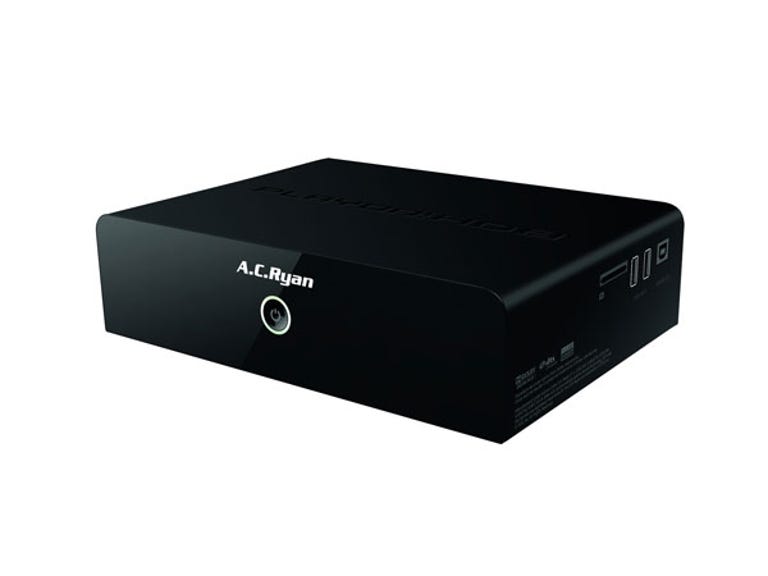 Why You Can Trust CNET
Why You Can Trust CNET AC Ryan Playon!HD2 review: AC Ryan Playon!HD2
The Playon!HD2 is an unusual mix of excellent format support with terrible documentation, serious stability issues and whacky GUI control choices. It's inexpensive, but unless firmware updates can address the control and stability issues, it's a poor choice.
Design
We were saddened by the AC Ryan Playon!HD Essential when we reviewed it recently, and at least visually, the Playon!HD2 doesn't appear to be all that different, with a plain plastic case with the AC Ryan logo embedded in the top, a variety of input sockets on the right-hand side and a single glowing power button at the front. We've certainly seen uglier media-streaming boxes, but not that many of this particular size.
The Good
The Bad
The Bottom Line
We wouldn't normally note this, but the Playon!HD2 comes with rather more than most players in terms of inbox contents. You name it, and AC Ryan's thrown it in the box, from Ethernet cable to USB 3.0 cable to HDMI cable. None of these things are spectacularly valuable in and of themselves, but their inclusion means that anybody buying one will be able to connect it up without having to worry about any additional cable purchases at all.
Features
The Playon!HD2 is a little cheaper than the Essential, but that's not the only difference. The HD2 has one feature we really keenly felt was missing from the Essential, namely in-built network support via gigabit Ethernet. The optional AU$39 802.11n Wi-Fi adapter can also be used with the HD2, but in our experience for anything but SD video, most Wi-Fi set-ups will still struggle with displaying a reliable picture.
The base price of the HD2 is actually cheaper than that of the networking-free HD Essential we reviewed recently, but that's because it omits any kind of hard drive. Our review sample featured a 500GB hard drive, and it's worth checking what kind of storage (if any) a retailer's putting into it for a given price point. Drives go into the side of the unit and are very simple to install and uninstall underneath the small clipped-on cover. AC Ryan dubs this the Ez Drive Slot and as hard drive installations go, it's certainly simple.
In terms of online media features, there's support for Twitter, Facebook, Picasa, Flickr, YouTube and a number of Yahoo-specific feeds. There's also in-built torrent support, although this is one area where the GUI does itself no favours in terms of making it obvious how to set up and run torrents through the Playon!HD2. We tried the quick start guide, but that was no use, and AC Ryan's support forums suggest that a full product manual is "coming soon". Digging around the support website revealed that the torrent client is controlled from a web GUI from any PC on the same network; a pointer to this from the GUI (or in the quick start guide) would have been a good idea.
Codec support is, as with the Essential, very wide indeed. The official list reads as follows: AVI, MKV, TS, TP, TRP, M2TS, MPG, MP4, MOV, M4V, VOB, ISO, DVD-ISO, IFO, DAT, WMV, ASF, RM, RMVB, FLV and BD-ISO. Naturally, you'd be expected to just have all those formats lying around, perfectly legally. Ahem.
Performance
The Playon!HD2 uses the same interface as the Essential did, and this has both its good and bad sides. Good, because it's a visually rich GUI that presents well on a decent-sized display screen. Bad, because it's plagued with inconsistent choices as to how you navigate around the page. There's a fundamental lack of logic present within the HD2's menu structures. As an example, in the set-up menu, to move between categories, the visual layout would suggest hitting the left-hand side of the control pad. Instead, this function's been mapped to the up and down chapter buttons. There's no real reason why this makes more sense or helps anyone. It's just bad design, and it's particularly galling on a display that otherwise looks so clean and crisp.
Not surprisingly, we struggled to find a video file that the Playon!HD2 wouldn't start playing. We've chosen our words carefully there, as we hit more than a few files that either crashed the player, or caused it to revert back to its menu, or sent through either no audio or a high-pitched beeping tone only. Stability, in other words wasn't a strong point of the Playon!HD2. An especially annoying factor here is that (at least based on our tests) when the Playon!HD2 locks up, it does so for keeps, requiring the power to be pulled from the back of the unit to get any sense out of it at all. While we're on a complaints kick, it's also worth noting that the internal fan on the HD2 is quite noisy. If you're putting it into a cabinet that you'll sit a fair way away from, this isn't an issue, but for smaller bedsit-type rooms, you'll notice it whirring away constantly.
Conclusion
The Playon!HD2 should be a player we'd love. It fixes the worst problem we had with the Essential by adding Ethernet support, and even adds extras such as gigabit Ethernet rather than 10/100 and USB 3.0 support. It'll play back BD-ISO files. The GUI looks great.
Sadly, though, we can't recommend it, simply because for the vast majority of the time we spent with it, we struggled to keep it playing files all the way through, dealt with a gorgeous-looking GUI undone by weird control choices, and ultimately found it less entertaining and a whole lot more frustrating than any home AV product should actually be.


